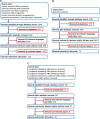Targeted Therapies for Skeletal Muscle Ion Channelopathies: Systematic Review and Steps Towards Precision Medicine
- PMID: 33325393
- PMCID: PMC8203248
- DOI: 10.3233/JND-200582
Targeted Therapies for Skeletal Muscle Ion Channelopathies: Systematic Review and Steps Towards Precision Medicine
Abstract
Background: Skeletal muscle ion channelopathies include non-dystrophic myotonias (NDM), periodic paralyses (PP), congenital myasthenic syndrome, and recently identified congenital myopathies. The treatment of these diseases is mainly symptomatic, aimed at reducing muscle excitability in NDM or modifying triggers of attacks in PP.
Objective: This systematic review collected the evidences regarding effects of pharmacological treatment on muscle ion channelopathies, focusing on the possible link between treatments and genetic background.
Methods: We searched databases for randomized clinical trials (RCT) and other human studies reporting pharmacological treatments. Preclinical studies were considered to gain further information regarding mutation-dependent drug effects. All steps were performed by two independent investigators, while two others critically reviewed the entire process.
Results: For NMD, RCT showed therapeutic benefits of mexiletine and lamotrigine, while other human studies suggest some efficacy of various sodium channel blockers and of the carbonic anhydrase inhibitor (CAI) acetazolamide. Preclinical studies suggest that mutations may alter sensitivity of the channel to sodium channel blockers in vitro, which has been translated to humans in some cases. For hyperkalemic and hypokalemic PP, RCT showed efficacy of the CAI dichlorphenamide in preventing paralysis. However, hypokalemic PP patients carrying sodium channel mutations may have fewer benefits from CAI compared to those carrying calcium channel mutations. Few data are available for treatment of congenital myopathies.
Conclusions: These studies provided limited information about the response to treatments of individual mutations or groups of mutations. A major effort is needed to perform human studies for designing a mutation-driven precision medicine in muscle ion channelopathies.
Keywords: Non-dystrophic myotonia; calcium channel; chloride channel; congenital myasthenic syndrome; congenital myopathy; periodic paralysis; precision medicine; sodium channel; targeted therapy.
Conflict of interest statement
JFD is co-inventor of the international patent “safinamide for treating myotonia” (number WO 2019/22902S A1).
Figures


References
-
- Desaphy J-F, Conte Camerino D, Franchini C, Lentini G, Tortorella V, De Luca A. Increased hindrance on the chiral carbon atom of mexiletine enhances the block of rat skeletal muscle Na+channels in a model of myotonia induced by ATX. Br J Pharmacol. 1999;128(6):1165–74. doi: 10.1038/sj.bjp.0702901 - DOI - PMC - PubMed
Publication types
MeSH terms
Substances
LinkOut - more resources
Full Text Sources
Other Literature Sources
Miscellaneous

